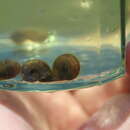pt-BR
nomes no trilho de navegação


Planorbarius metidjensis is a freshwater lung snail. [2]
Experiments confirmed it to be a host of the Schistosoma parasites, while the Bulinus truncatus freshwater snail has been known much longer as a carrier of schistosomiasis.[3]
The snail measures 8 mm x 16 to 18 mm. The shell is light yellowish, while the periostracum is brown, reddish or greenish. The body is nearly black with a grey foot and tentacles.[4]
While P. metidjensis has been successfully infected with Schistosoma haematobium in the laboratory, in Morocco, no free-living infected snails have been found during a survey.[5] Likewise, in the laboratory, snail specimens from Portugal and Salamanca were found to be very susceptible to infections by Schistosoma bovis strains gathered from the Salamanca region, but the 1977 study urged a prevalence survey of free-living snails.[6]
In some areas, there are S. haematobium/S. bovis hybrids. P. metidjensis is immune to experimental infection with hybrid parasites collected in Corsica that contain 23% genetical material from S. bovis.[7]

The snail occurs in southwestern Morocco[3] as well as in Algarve (Portugal) and Salamanca (Spain).[6]
In a 2007 study carried out in Morocco, the snail was found in larger altitudes, and not in man-made water bodies like canals and artificial lakes. It tolerated a wide range of electrical conductivities (120 to 3650 microsieverts/cm) and up to 1.1 grams of chlorides per liter. It was often found together with Ancylus fluviatilis river snails.[3]
page(s): 217, fig. 101c
Planorbarius metidjensis is a freshwater lung snail.
Experiments confirmed it to be a host of the Schistosoma parasites, while the Bulinus truncatus freshwater snail has been known much longer as a carrier of schistosomiasis.